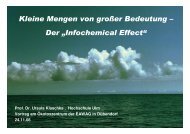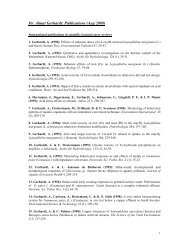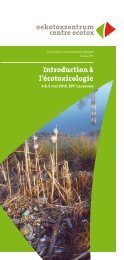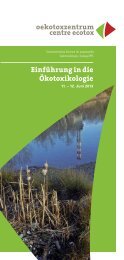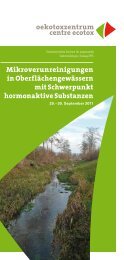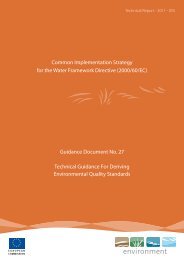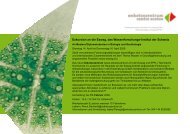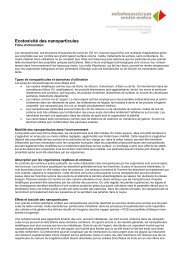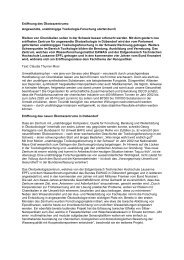Evaluation of Bioassays and Wastewater Quality ... - Oekotoxzentrum
Evaluation of Bioassays and Wastewater Quality ... - Oekotoxzentrum
Evaluation of Bioassays and Wastewater Quality ... - Oekotoxzentrum
You also want an ePaper? Increase the reach of your titles
YUMPU automatically turns print PDFs into web optimized ePapers that Google loves.
division. This event is referred to as mutagenicity, the heritable, irreparable consequences <strong>of</strong><br />
genotoxicity.<br />
Hormonal Effects: WWTPs are the main source <strong>of</strong> hormonally active chemicals, <strong>and</strong> discharge<br />
their effluent directly into surface waters. Estrogenic substances have a high risk potential in<br />
susceptible waterbodies (NFP 50, 2008), being especially important as they have a wide range<br />
<strong>of</strong> implications on organisms <strong>and</strong> ecosystems (e.g. Kidd et al., 2007) <strong>and</strong> may affect the health<br />
<strong>and</strong> reproduction <strong>of</strong> wildlife in very low concentrations (e.g. Burkhardt-Holm et al., 2005; NFP 50,<br />
2008). Therefore, special attention to those substances was paid in the performance<br />
assessment.<br />
Estrogenicity was measured using receptor-based in vitro systems. The binding <strong>of</strong> estrogenic<br />
substances to the human estrogen receptor (hER) was assessed using the YES (Routledge <strong>and</strong><br />
Sumpter, 1996) <strong>and</strong> the ER CALUX assays (Van der Linden et al., 2008).<br />
Apart from estrogenic substances, various other hormonally active substances can be present in<br />
the water which may exert effects on organisms. To test if those substances can also be<br />
removed by advanced wastewater treatment, the effects on various hormone receptors (such as<br />
the <strong>and</strong>rogen, glucocorticoid, progesterone <strong>and</strong> thyroid hormone receptor) were assessed with<br />
several CALUX assays (Van der Linden et al., 2008).<br />
The cellular effects <strong>of</strong> hormonally active substances on hormone production <strong>and</strong> metabolism was<br />
measured by quantifying cellular hormone levels through the H295R steroidogenesis assay,<br />
which uses a human cell line <strong>of</strong> adenocarcinoma cells able to produce steroid hormones (such<br />
as testosterone or estradiol) <strong>and</strong> integrates effects on all relevant metabolism pathways leading<br />
to the production <strong>of</strong> those hormones (Gracia et al., 2006).<br />
Herbicidal Effects: To assess specific effects <strong>of</strong> herbicides, in particular inhibitors <strong>of</strong> the<br />
photosystem II, the combined algae assay with the green algae Pseudokirchneriella subcapitata<br />
was performed. It detects specific effects on the photosynthesis <strong>of</strong> unicellular green algae as well<br />
as unspecific effects on cell growth (Schreiber et al., 2002).<br />
Most samples used for the bioassays described above were tested in enriched form, except for<br />
the micronucleus <strong>and</strong> the Ames assay, where native wastewater samples were assessed. In<br />
both variations different dilution steps were tested.<br />
St<strong>and</strong>ardised whole organism tests at different trophic levels, in vivo –assays<br />
Primary Producers: To assess effects <strong>of</strong> municipal wastewater on primary producers, growth<br />
tests were performed with the single-celled green algae P. subcapitata (using native wastewater<br />
samples, <strong>and</strong> growth as sole endpoint), <strong>and</strong> with the duckweed Lemna minor as representatives<br />
<strong>of</strong> higher water plants or macrophytes. Both organisms play a central role in the aquatic<br />
ecosystem. They serve as food source for organisms <strong>of</strong> higher trophic levels, such as<br />
crustaceans, mussels <strong>and</strong> other filtering <strong>and</strong> detritus feeding invertebrates or vertebrates.<br />
Additionally, macrophytes play an important role for the structure <strong>of</strong> a waterbody <strong>and</strong> serve as<br />
habitat for numerous species.<br />
Primary Consumers: The water flea Ceriodaphnia dubia was chosen as primary consumer <strong>and</strong><br />
filter feeder. They are amongst others feeding on green algae, <strong>and</strong> serve as an important food<br />
source for larval fish <strong>and</strong> other aquatic species. St<strong>and</strong>ardised tests with C. dubia are one <strong>of</strong> the<br />
Swiss Centre for Applied Ecotoxicology, Eawag/EPFL · Überl<strong>and</strong>strasse 133 · CH-8600 Dübendorf<br />
www.oekotoxzentrum.ch<br />
10



